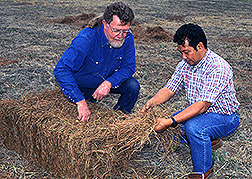Pine Needles—a Hot, New Commodity
|
|
Money doesn't grow on trees. But for the rural landowner with even a few acres of pine tree plantings, Catalino Blanche has a suggestion that could be the next-best thing.
"Harvesting the pine needles that fall off the trees can give you a nice interim cashflow during the 20 to 30 years before the trees themselves are big enough to be harvested," says Blanche, who is an agriforester at the ARS South Central Family Farms Research Center located at Booneville, Arkansas.
"Here in Arkansas, we can harvest as many as 150 bales of needles, called pine straw, per acre—at 30 to 40 pounds per bale—and sell them for as much as $8 apiece, starting when the trees are about 8 years old." The needles are a hot commodity among landscapers and builders.
"Landscapers prefer pine straw mulch to bark nuggets or wood chips, because the pine straw doesn't wash away as easily," Blanche explains. "It's a nice color, and it will eventually break down, providing extra organic matter for the soil.
"Builders like to spread pine straw at building sites to prevent the soil from being disturbed too much by their heavy equipment," he says. "The demand for pine straw is much greater than the supply."
But pine straw harvesting is very labor-intensive, Blanche warns. While the straw can be baled with the same machinery used to bale hay, it must first be raked into piles, with care taken to avoid sticks and other trash that could lower the value of the product.
Another potential drawback is the impact of straw harvesting on the growing trees.
"Shedding of needles is the way the tree returns nutrients to the soil to help nourish itself," Blanche explains. "Our studies indicate that you lose 40 pounds of nitrogen per acre by harvesting 100 bales of straw per acre.
"Still, 238 pounds of 28-8-8 fertilizer per acre would be enough to replace the nitrogen, phosphorus, and potassium you've taken away. That would cost only about $27 per acre, against income of $600 if 150 bales per acre were sold for $4 apiece."
Still unresolved is the potential impact of moisture loss in summer, as soil around the tree is left bare by straw harvesting.
"We're looking now at leaving a certain amount of straw on the ground under the trees to minimize water stress that can reduce growth significantly," Blanche says.
Pine straw can be harvested anytime during the trees' shedding season, from August to January. But the harvest could be timed to reduce adverse impact on the growing trees, according to Blanche.
"Studies have shown the maximum harvest is in October and November," he reports. "But harvesting in February could minimize the impact on the ecological system because the straw would have been in place through the winter, protecting the trees' root system from freezing temperatures.
"That's particularly important in the Midsouth, because tree root systems stay relatively active here, even in winter, and therefore are more susceptible to damage."
In field tests with 16-year-old loblolly pine stands at Hope, Arkansas, from 1990 to 1995, pine straw yields averaged 480 pounds per acre in August, slightly more in September and October, and a maximum of 1,603 pounds per acre in November. But at the higher elevations on Petit Jean Mountain near Morrilton, Arkansas, and at Booneville, greatest yields have come in October.
"The whole idea here is to get some interim cashflow," Blanche concludes. "Pine straw is a value-added product. And now we know it's economically feasible for the small landowner.
"Those who have larger pine plantings might lease the land for pine straw harvesting at $10 to $25 per acre. This is a new source of income for rural areas." — By Sandy Miller Hays, ARS.
"Pine Needles -- a Hot, New Commodity" was published in the May 1996 issue of Agricultural Research magazine.







